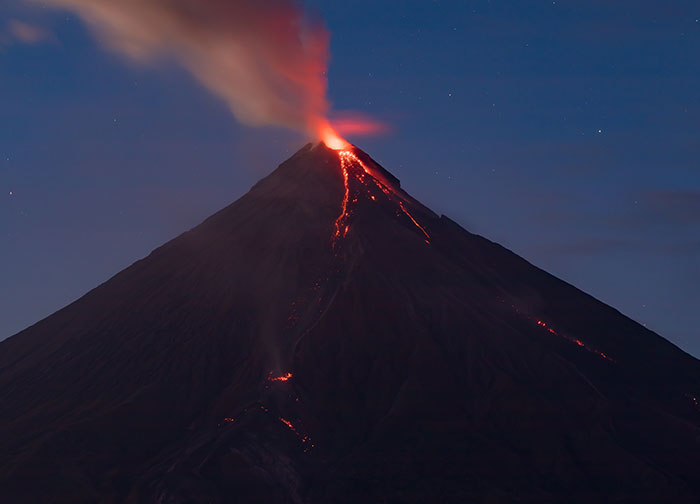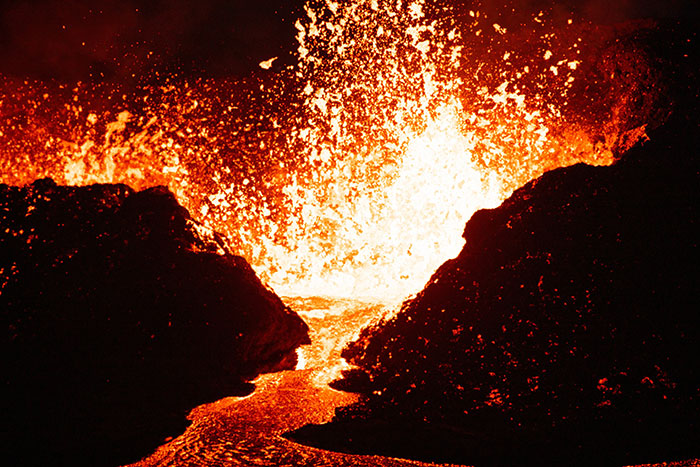
Experts Raise The Alarm About Incoming Massive Volcanic Eruption: “Humanity Does Not Have Any Plan”
Scientists are raising the alarm about a massive volcanic eruption that is looming on the horizon.
Warnings revealed that there is a one-in-six chance of a massive eruption taking place this century, according to Markus Stoffel, a climate professor at the University of Geneva.
As the world grapples with the mounting effects of climate change, humanity has no “plan” on how to deal with the potential disaster, he added.
- Scientists have given a warning of a 1-in-6 chance of a catastrophic volcanic eruption this century.
- “Humanity does not have any plan,” said Markus Stoffel, a climate professor.
- If Yellowstone sees an explosion, “the aftermath” wouldn’t “be pleasant,” said another expert.
While volcanoes have erupted over the years, the last world-changing volcanic eruption was in 1815, when Indonesia’s Mount Tambora exploded and released 24 cubic miles of gases, dust, and rock into the atmosphere.
Scientists have given a warning of a 1-in-6 chance of a catastrophic volcanic eruption this century
Image credits: worldimage/stock.adobe.com (Not the actual photo)
About 10,000 people were instantly killed from the impact on the island of Sumbawa, and the death toll later climbed up to 90,000.
The disaster was the most powerful eruption in recorded history and led to the “year without a summer” as global temperatures took a nosedive.
The planet cooled down, crops were destroyed, starvation was rampant, and thousands died from a cholera pandemic.
Now, scientists believe the next massive eruption of such a destructive scale would take place this century.
It will “cause climate chaos,” and “humanity does not have any plan,” Stoffel told CNN.
Humanity has no “plan” on how to deal with the potential disaster, climate professor Markus Stoffel said
Image credits: Tomáš Malík/Wirestock Creators/stock.adobe.com (Not the actual photo)
If a disaster like the 1815 eruption of Mount Tambora takes place in the 21st century, the impact would be far worse due to the the dependence on fossil fuels and the human-induced climate change.
“It’s a more unstable world now,” Michael Rampino, a professor at NYU, who investigates links between volcanic eruptions and climate change, told CNN.
“The effects might be even worse than we saw back in 1815,” the professor added.
Research led by volcanologist Dr. Thomas Aubry reveals that a hotter and more volatile atmosphere would distribute sulfur dioxide gas—released during eruptions—more efficiently.
The 1815 Mount Tambora eruption had a devastating impact on the planet and instantly killed 10,000 people
Image credits: Visit Tambora
Image credits: NASA Earth Observatory
This gas forms sulfate aerosols that reflect sunlight, potentially intensifying global cooling. Cambridge atmospheric scientist Dr. Anja Schmidt adds that these particles’ size matters greatly, with an optimal range making them even more effective at blocking solar energy.
Ironically, the greenhouse gases we have pumped into the atmosphere would make the planet warmer, but the aftermath of a volcanic eruption would be even colder.
“There is a sweet spot in terms of the size of these tiny and shiny particles,” Anja said.
At a “just right” size range, they would be “very efficient at scattering back the sunlight.”
In the future, a hotter atmosphere would eventually remove 30 percent more solar energy in certain ‘global warming’ scenarios coming soon.
“We suggest that would amplify the surface cooling by 15 percent,” according to volcanologist Dr. Thomas Aubry.
Temperatures plummeted after Mount Tambora’s 1815 eruption and led to the “year without a summer”
Image credits: Rob Wood
Image credits: Wikimedia Commons/Giorgiogp2
Scientists say that the next massive volcanic eruption could take place anywhere in the world, and they are mainly keeping their eyes on America’s Yellowstone and on Indonesia, one of the most volcanically active regions of the globe.
“Which one next and when — that’s still impossible to predict,” Stoffel told the outlet.
“We’re just at the beginning of getting an idea of what could happen,” he added.
He suggested that experts should run stress tests and also analyze and prepare for possible scenarios in case of a massive disaster. The formulated plans should include strategies to ensure food supply and safe evacuation.
Volcanic eruptions are currently in the news as Hawaii’s Kilauea volcano, one of the most active ones in the world, erupted on Monday, December 23.
If Yellowstone sees an explosion, “The aftermath of such an explosion wouldn’t be pleasant,” an expert said
Image credits: Aerial Film Studio/stock.adobe.com
A lake of lava covered about 500 acres of the caldera floor within hours of the eruption. Visitors flocked to the Hawaii Volcanoes National Park to witness the spectacle.
Additionally, a volcano in southwestern Iceland that was dormant for about 800 years erupted at least seven times this year.
It is also impossible to have a discussion about massive volcanic eruptions without mentioning America’s beloved Yellowstone. The Yellowstone National Park region has experienced three massive eruptions in Earth’s history.
While a Yellowstone eruption would be destructive, experts believe it would not lead to the “end of the human race”
Image credits: Zimu/stock.adobe.com
The Yellowstone Supervolcano, a massive volcanic system beneath the national park, is one of the largest active volcanic systems on the planet and could cause significant destruction.
“Most Yellowstone eruptions do not fit this worst-case scenario,” Mike Poland, Scientist-in-Charge of the Yellowstone Volcano Observatory said but added, “The aftermath of such an explosion wouldn’t be pleasant.”
Poland believes that if Yellowstone’s supervolcano awakens, it could leave even surrounding states in bad shape.
He told the Daily Mail that such an event, although destructive, would not lead to the “end of the human race.”
“I’d prefer the asteroid instead,” remarked one social media user while another speculated, “Yellowstone is next”
Poll Question
Thanks! Check out the results:
It's not like we can stop it happening, and WW3 is just as realistic an option as well. It's case of which comes first.
A massive volcanic eruption is a certainty. The only questions are when and where. WWIII is a possibility of an unknowable likelihood.
Load More Replies...If it's going to happen, we can't do anything about it. So why worry ?
Exactly. Eff all we can do about it, or WW3 either, so no point fretting. Just bless each day you have. We all came from stardust, and to stardust we will eventually return, so if the worst happens, see you on the other side, fellow pandas x
Load More Replies...Like the farmers almanac always says, "you can only keep just so many hogs per acre and have them remain viable and productive. This planet could easily be ruined by the human "hogs" who it seems, are hell bent on depleting all of its resources as quickly as possible. Global daily oil consumption is at one million two hundred thousand barrels a day currently, that alone should be cause for grave concern.🤔
It's not like we can stop it happening, and WW3 is just as realistic an option as well. It's case of which comes first.
A massive volcanic eruption is a certainty. The only questions are when and where. WWIII is a possibility of an unknowable likelihood.
Load More Replies...If it's going to happen, we can't do anything about it. So why worry ?
Exactly. Eff all we can do about it, or WW3 either, so no point fretting. Just bless each day you have. We all came from stardust, and to stardust we will eventually return, so if the worst happens, see you on the other side, fellow pandas x
Load More Replies...Like the farmers almanac always says, "you can only keep just so many hogs per acre and have them remain viable and productive. This planet could easily be ruined by the human "hogs" who it seems, are hell bent on depleting all of its resources as quickly as possible. Global daily oil consumption is at one million two hundred thousand barrels a day currently, that alone should be cause for grave concern.🤔

 Dark Mode
Dark Mode 

 No fees, cancel anytime
No fees, cancel anytime 









































































29
9